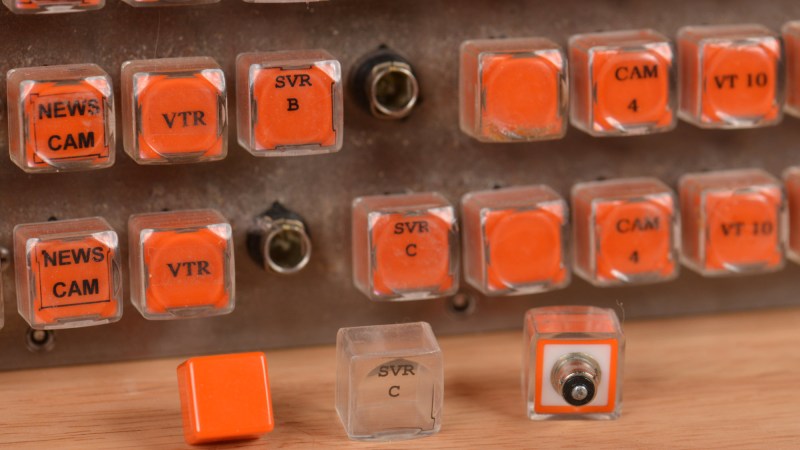Video effects and mixing are done digitally today, but it wasn’t always so. When analog ruled the video world, a big switch panel was key to effective results.

Devices like [Glen]’s Grass Valley Series 300 Crosspoint Switch Panel were an important part of that world. With tools like that, a human operator could set up a composited preview feed in true WYSIWYG style, and switch to live on cue. All done with relatively simple CMOS ICs and buttons. Lots and lots of buttons.
[Glen] reverse engineers the panel to show how it works, and most of the heavy lifting is done by the MC14051B analog multiplexer/demultiplexer, and the MC14532B 8-bit priority encoder. Once that’s figured out, the door is open to modernizing things a little by using a microcontroller to drive the device, turning it into a USB peripheral.
With a little design work, [Glen] builds a PCB around the EFM8UB2 8-bit microcontroller to act as a USB peripheral and control the switch panel, taking care of things like key scanning and lamp control. The last step: a GUI application for monitoring and controlling the panel over USB.
This isn’t [Glen]’s first time interfacing to vintage video mixing and switching, and as many of us know it’s sometimes tricky work to interface to existing hardware. We covered his earlier video switcher project using hardware that was not nearly as easy to work with as this one.
















Ah, the GVG 300, a mainstay of scifi films, standing in for the control surfaces of reactors and space ships for years. One push of the mix lever could beam you to the moon and back, with a neat rising tone too.
I guess this one wasn’t equipped with an M/E2 effects memory module, which used serial control to do the switching / keying setup for the board. Interfacing with those was a breeze. Sports TDs would carry diskettes of their favorite setups from site to site.
For those (like me) not familiar with the device, here’s a 1970s promo/sale videos of the GVG 300 capabilities:
https://www.youtube.com/watch?v=IPDoNRYKiMc
Funny – this is a long-form advertisement, but at 4:55, there’s a badly keyed graphic overlay, where there are black flickering artifacts on the ski.
Looks more like a video recording error (clipping) to me.
Either way, it shows a rather low level of expectations from the technology, when you include that in showing off your premium equipment.
All those switching effects gave me flashbacks to the early 1980s!
TBH with analog you get signal that is infinitely accurate (dependent only on how good your amplifier is). With digital it’s soaprated into different pixels, either it’s on or off, no inbetween. It’s good for doing logic computations (like in PLC) but wrong for continuous record like video or music.
Get your own username and don’t use mine!
Yes, I remember those “infinitely accurate” VHS recordings we used to do.
I’ve used at least a dozen different video switchers from the late 1990s to .. earlier today. Almost all of them use a simple electrical interface, from RS-232 or RS-485 to 10base-T Ethernet to USB, to connect the hundreds of buttons and knobs from the panel in the control room to the switcher itself, usually located in a different room. These control panels often cost more than the switcher itself, mainly due to the expensive switches used. For example, I worked for an organization that spent $2200 for a switcher, and over $5000 for the control panel for it. And that was the “budget” panel – the one that could control features such as picture-in-picture and chroma keying, sold for $15,000. Which is just insane, since the software control panel is free, includes all of the same controls (and then some), and runs on practically any laptop.
USB.. *ugh* That’s the least I want to use to drive a professional equipment with.
Why not use something more, um, “professional” than this cheap consumer’s tech? It’s disrespectful anddevaluing the panel, imho.
Why not use something like a serial or parallel interface? Or SCSI? DB25 and Centronics have real, shielded connectors with mounting screws. 🙂
Both can be interfaced with USB adapters, too. Real LPT-USB comverters exist, too.
https://www-user.tu-chemnitz.de/~heha/basteln/PC/USB2LPT/ul-16.en.htm
Now that you mention it, I think the only panel I used that was USB was a TriCaster, which was also the least reliable, least professional of all. But I think that parallel or SCSI are WAY overkill, and USB is just fine for what these panels are — glorified keyboards!
https://bikerglen.com/wp/wp-content/uploads/2021/02/eb5d3c6275367d1076f02401455e9036.jpg
That’s some serious hardware p0rn. I love things like (old) mixing tables for audio or control tables for lighting or stuff like this with lots and lots of buttons. Today it is probably mostly touchscreens i guess? But yeah, this (old) stuff is expensive, because good quality buttons and pots and so on are not cheap.